28 Apr Explore “street art, folk art, quilting, nostalgia, and community building” with Taylor Shaw this summer
[vc_row css_animation="" row_type="row" use_row_as_full_screen_section="no" type="full_width"...

[vc_row css_animation="" row_type="row" use_row_as_full_screen_section="no" type="full_width"...
[vc_row css_animation="" row_type="row" use_row_as_full_screen_section="no" type="full_width"...
[vc_row css_animation="" row_type="row" use_row_as_full_screen_section="no" type="full_width"...
[vc_row css_animation="" row_type="row" use_row_as_full_screen_section="no" type="full_width"...
One of Pepper’s specialties is...
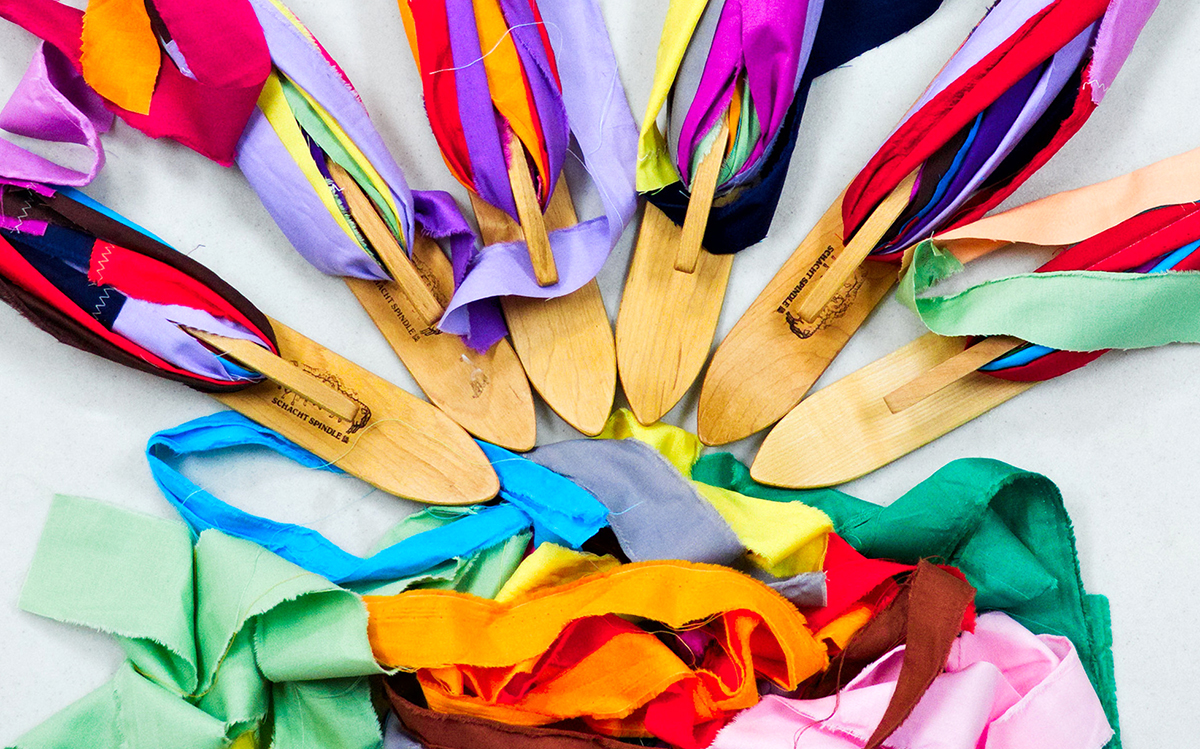 Weavers' Work Week is an annual tradition at the Folk School where skilled weavers are invited to come for a week and volunteer their time to do projects around campus and make improvements in the studio. Let's learn more about the week from Pam Howard, longtime Weaving Resident Artist.
[caption id="attachment_18687" align="alignright" width="246"]
Weavers' Work Week is an annual tradition at the Folk School where skilled weavers are invited to come for a week and volunteer their time to do projects around campus and make improvements in the studio. Let's learn more about the week from Pam Howard, longtime Weaving Resident Artist.
[caption id="attachment_18687" align="alignright" width="246"]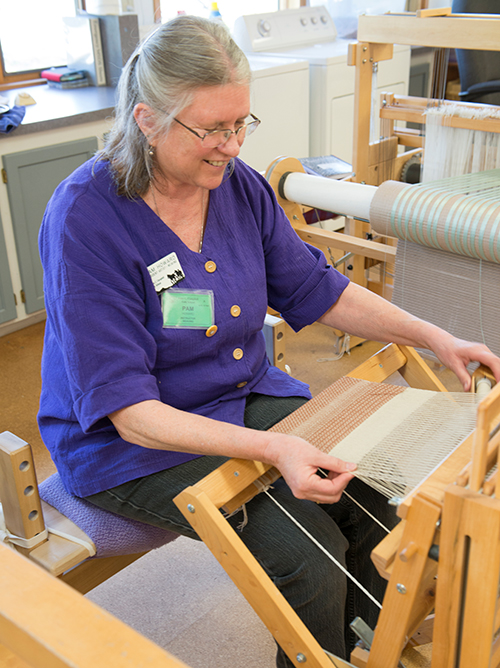 Pam Howard at the loom[/caption]
CP: What is Weavers' Work Week, and how did it start?
PH: The idea for Weavers' Work Week started in 1992. A weaving teacher, Betty Hancock Smith and her weaving student, Dee Richard were talking about how hard it was sitting all week on the loom benches. Those two got to talking about what if weavers were invited to come to the school and weave fabric to make the cushions. They asked Jan Davidson, former director and Ruth Truett, former programs director. It was approved, and in the spring of 1993 the first Weavers' Work Week happened.
I was assisting Betty in her weaving class in 1992, and I was the first weaver that was asked to participate. I have been to every one since. From 1993 to 2000, Betty was in charge of organizing the yearly event. In 2000, I became the Resident Weaver and took it over organizing it. Things went on fairly smoothly till 2008 when I had health issues and inherited relatives I had to take care of. After the dust settled and things had calmed down in my life, I thought it was time to restart the tradition of WWW. So, on February 4, 2015 I sent a letter to the “powers that be” and got Weavers' Work Week back on the schedule.
Pam Howard at the loom[/caption]
CP: What is Weavers' Work Week, and how did it start?
PH: The idea for Weavers' Work Week started in 1992. A weaving teacher, Betty Hancock Smith and her weaving student, Dee Richard were talking about how hard it was sitting all week on the loom benches. Those two got to talking about what if weavers were invited to come to the school and weave fabric to make the cushions. They asked Jan Davidson, former director and Ruth Truett, former programs director. It was approved, and in the spring of 1993 the first Weavers' Work Week happened.
I was assisting Betty in her weaving class in 1992, and I was the first weaver that was asked to participate. I have been to every one since. From 1993 to 2000, Betty was in charge of organizing the yearly event. In 2000, I became the Resident Weaver and took it over organizing it. Things went on fairly smoothly till 2008 when I had health issues and inherited relatives I had to take care of. After the dust settled and things had calmed down in my life, I thought it was time to restart the tradition of WWW. So, on February 4, 2015 I sent a letter to the “powers that be” and got Weavers' Work Week back on the schedule.
...
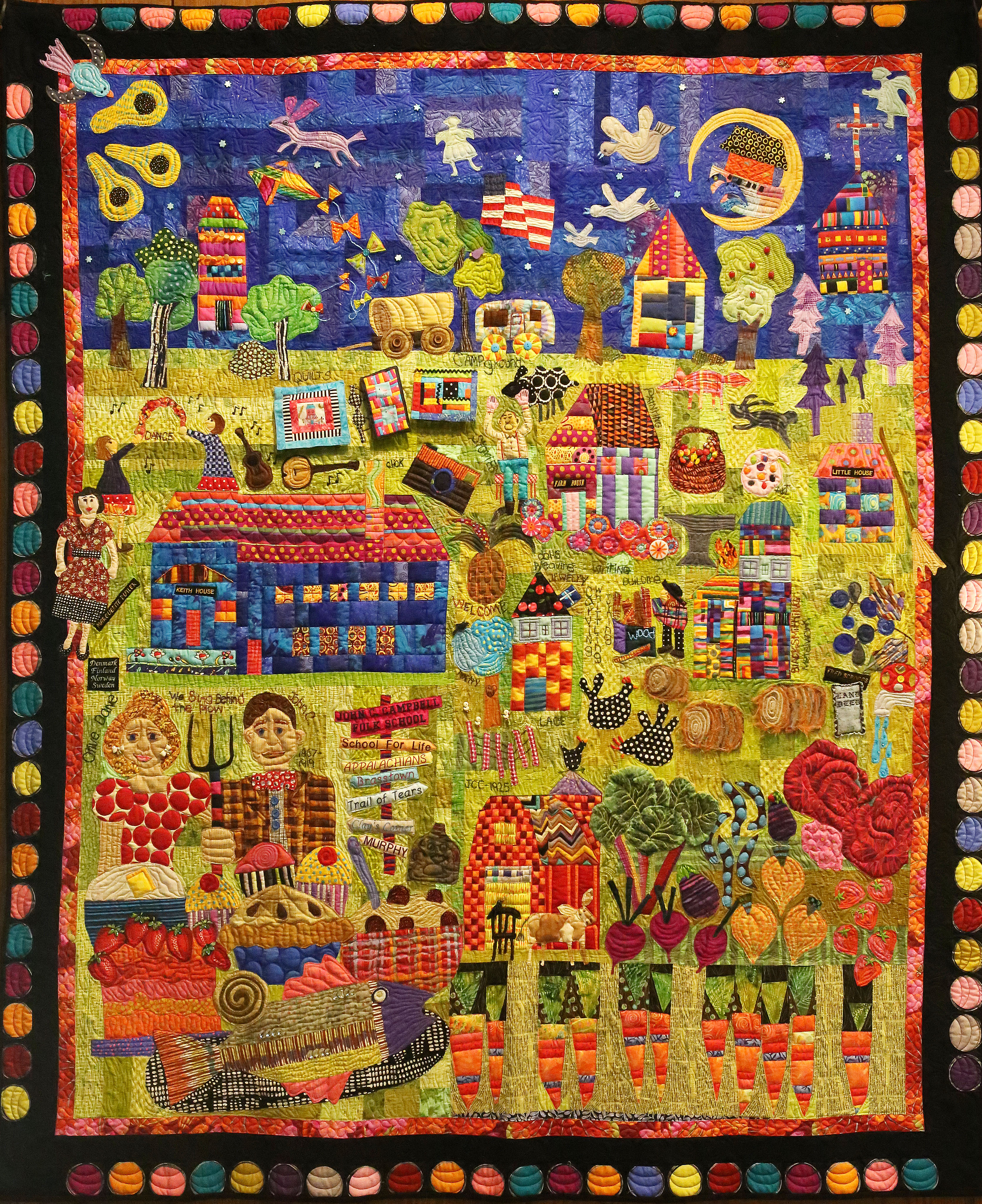 Instructor Mary Lou Weidman of Spokane, Washington recently sent us a quilt depicting the story of the Folk School. Three and a half years in the making, the wonderfully colorful and imaginative quilt is hanging on display in the Community Room of Keith House.
Instructor Mary Lou Weidman of Spokane, Washington recently sent us a quilt depicting the story of the Folk School. Three and a half years in the making, the wonderfully colorful and imaginative quilt is hanging on display in the Community Room of Keith House.
"I was told about JCC by instructor DeeDee Triplett who told me that making money teaching was not the main reason for being there. And the first time I taught there I knew just what she meant. The people, the feeling of community and joy was what it was about. Meeting people from all over in the dining room and hearing experiences and seeing people help each other and in the end hug and wave "Goodbye" was lovely. People were happy with projects and a week of loveliness in the meadows and gardens and just walking along the paths is joyful. Imagining those that came before you is a nice thing to do also while you look at butterflies and nature and lovely wrought iron and folk art here and there. It is a pleasure to come and enjoy all there is, including music and dancing at night. This is a great place to work on gratitude and all that God can provide in one lovely place.
I decided to work on a quilt because there is so much to tell stories about there. Once I got into designing it, I realized that it should be a series of quilts because there is so much to tell and not enough room in one quilt. But I did the best I could and wanted to have John and Olive and Marguerite and the deed for the property from Fred Scroggs as that seemed very important to say. I worked for over three years on this quilt and Kathy Woods quilted it for me. Connie Donaldson my neighbor worked on it too and we both read many of the catalogues and other things online for ideas. Then we had too many ideas and so we did the best we could.
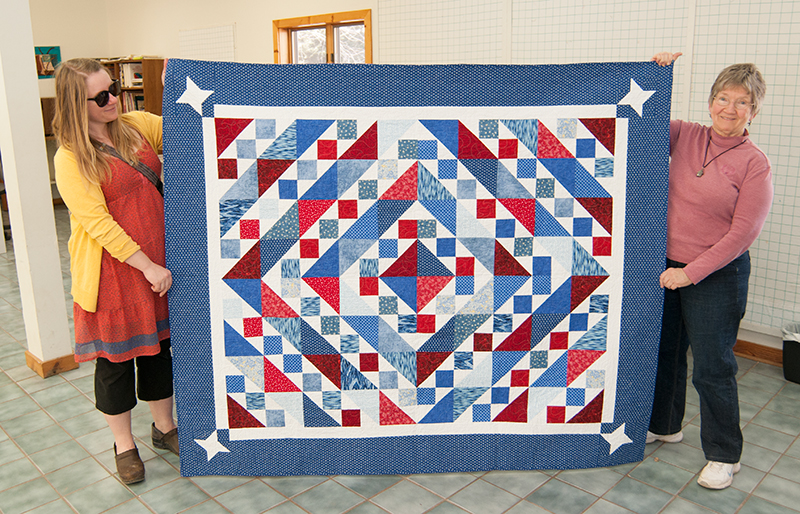 Julie Johnson and Alice Russell hold up Alice's "Quilt of Valor"[/caption]
Julie Johnson and Alice Russell hold up Alice's "Quilt of Valor"[/caption]
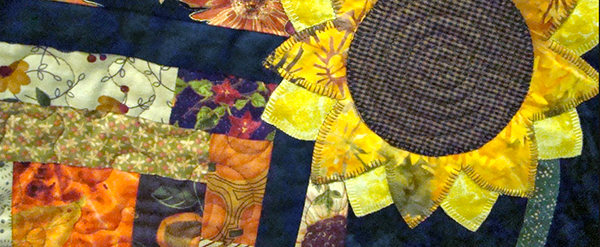 Detail of "It's Fall, Y'all: Fun Scrappy Autumn Quilt" by Audrey Hiers[/caption]
[caption id="attachment_12018" align="alignright" width="227"]
Detail of "It's Fall, Y'all: Fun Scrappy Autumn Quilt" by Audrey Hiers[/caption]
[caption id="attachment_12018" align="alignright" width="227"]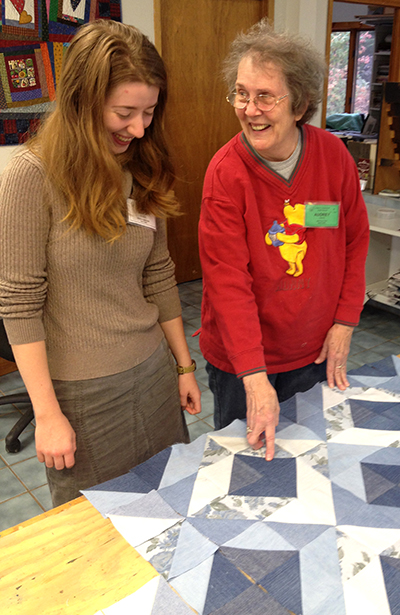 Audrey teaches Sara about quilt design in the Folk School Quilting Studio.[/caption]
CP: How did you get so involved in the quilting world?
AH: Probably because of the quilting genes in the family. Both of my grandmothers quilted and although I never saw either of them at the frame, I do believe in heredity! You could say I fell into it, and once I tried it, I got hooked big time. I seriously started quilting in the early 80s and taught my first class in 1987.
CP: Has quilting changed since then?
Comparing quilting 1980s to now is like the difference between night and day. For the most part we still use fabric and that's about it.
CP: What’s your favorite holiday motif?
AH: My favorite holiday motif is a sprig of freshly cut pine with holly sprigs mixed in. Alone, it would be a holly leaf.
CP: How is Appalachian style quilting different from quilting in other regions? Does it have any distinctive characteristics?
Audrey teaches Sara about quilt design in the Folk School Quilting Studio.[/caption]
CP: How did you get so involved in the quilting world?
AH: Probably because of the quilting genes in the family. Both of my grandmothers quilted and although I never saw either of them at the frame, I do believe in heredity! You could say I fell into it, and once I tried it, I got hooked big time. I seriously started quilting in the early 80s and taught my first class in 1987.
CP: Has quilting changed since then?
Comparing quilting 1980s to now is like the difference between night and day. For the most part we still use fabric and that's about it.
CP: What’s your favorite holiday motif?
AH: My favorite holiday motif is a sprig of freshly cut pine with holly sprigs mixed in. Alone, it would be a holly leaf.
CP: How is Appalachian style quilting different from quilting in other regions? Does it have any distinctive characteristics?


